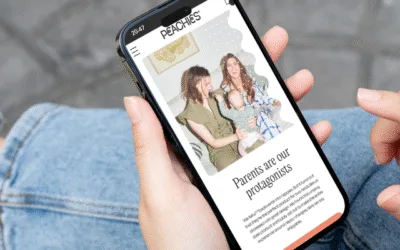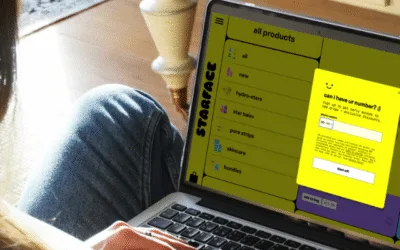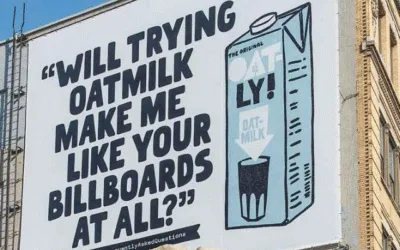Peachies beat Pampers by selling sleep, not nappies. Learn their Ladder of Why messaging trick to make your copy resonate.
How Patagonia chooses what to say (and how you can steal it)
Learn how Patagonia uses different types of messaging at each stage of the buyer journey and steal their strategy to make your own copy clearer and more effective.
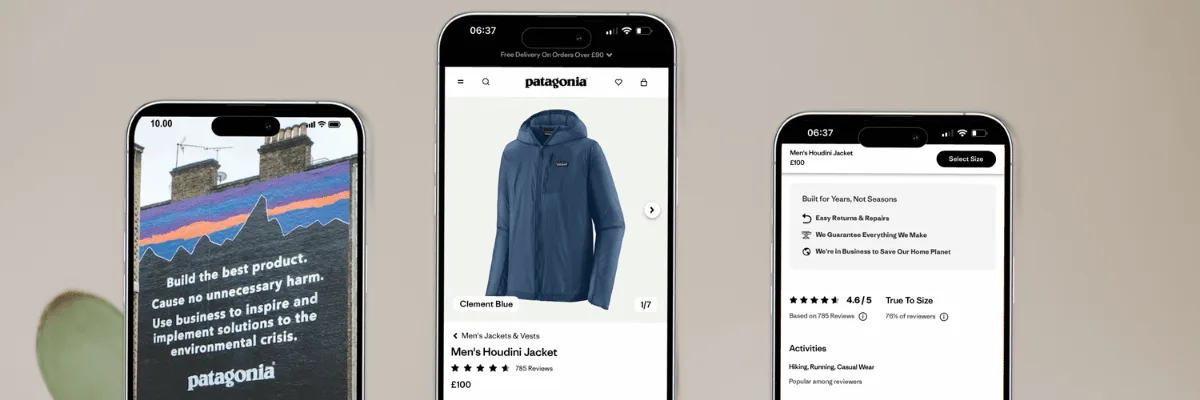
Get pro copy tips, branding tricks and e-comm insights directly to your inbox every Tuesday.
Struggling to get back up to full speed after the long weekend? Yeah, us too.
So this week, with everyone coming back to long to-do lists, we thought we’d focus less on the granular writing of the copy stuff and more on how to think like a copywriter.
Because half the battle when it comes to writing copy isn’t about finding the right words or nailing your voice, it’s knowing which approach to take.
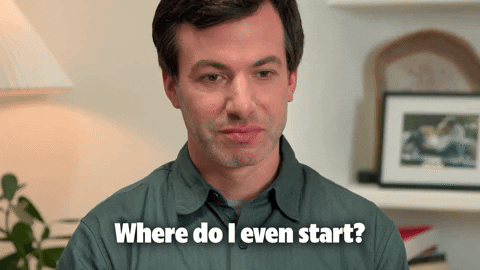
So we thought we’d give you a quick breakdown of how we’ve tackled that crippling analysis paralysis that comes from staring at the blank page and thinking of ALL THE POSSIBILITIES.
And a quick heads up: it’s not perfect. And it’s more a quick gut check than a hard and fast rule.
But it’s based on how our brains make decisions and it’s saved us countless hours going back and forth on “how do we approach this?” and more time writing the copy, getting it live and testing it out.
Let’s get into it 👇
💡 This week’s big idea: when you’re not sure what to say, zoom out and ask yourself one question: how close will the customer feel to the decision when they read this?
We’re all drowning in advice on how to write copy that converts.
LinkedIn is full of people sharing the copy tweaks they made that 10X-ed their sales.
ChatGPT can give you 20 different approaches to your headlines in 30 seconds.
And every week, you get a newsletter giving you more ways to do words gooder 😉
Which means that as you sit down to write, your head is swimming with things like “focus on the benefits”, “sell the lifestyle”, “highlight free shipping”, “reduce the friction”, “be concrete”…
And the really tricky thing? They’re all right.
And they’re also all wrong.
The key to writing really good copy is saying the right message in the right way at the right time to the right customer.
And the quickest way to figure out what “the right message” looks like is to ask yourself:
“How close to making a decision is the customer reading this likely to be?”
☝️That quick question is like licking your finger and putting it in the air when you’re flying a kite.
Is it going to give you wind speed and an exact direction? Absolutely not.
But it will give you enough information to get started and figure the rest out as you go.
Here’s why it works 👇
How our brains like to make decisions 🧠
There’s a theory in social psychology called Construal Level Theory (CLT) which basically says that the way we think about far-off choices is very different from the way we think about things we’re about to do.
When we’re far away from making a decision, we’re in something called high construal thinking but as we get closer and closer to hitting that “add to cart” button, we move down the scale to low construal thinking.
Here’s what that looks like in action 👇
- High construal thinking AKA zoomed out thinking. You’re thinking in big-picture terms, the gist, the purpose, why it matters, what buying this product would say about you, etc…
- Mid construal thinking AKA zooming in thinking. You’re starting to go from abstract, big-picture thinking into the specifics but you’re not at the nitty gritty yet. You’re thinking high-level plans, broad stroke details, imagining yourself after making the decision…
- Low construal thinking AKA zoomed in thinking. You’re thinking in specifics, next steps, features, how it works, prices, delivery dates, the nitty gritty of your plan.
Just think about how you decide to book a holiday, for example.
You start out thinking really zoomed out. (I need to get away for a while, I want to be relaxed, I want to feel like a local at the Sicilian market…)
Then, as you start to go from “hmm, I like that idea” to “hmm, maybe I should book it”, you start thinking of destinations, hotels, being by the pool, where you can visit. This is when you really start to picture yourself on the beach, book in hand and phone face down.
Then, as you’re ready to get it booked, you’ll move from comparing hotels and destinations to checking whether it’s ATOL protected, checking the baggage policies and making sure you’re 100% confident in your choice.
☝️ That’s how our brains make decisions.
So that’s the gut check we do before we start to write copy. That way, we know the rough direction we need to take with the copy before we’ve even put a pen to paper. (Or, a finger to the keys, more accurately.)
Steal this simple rule of thumb to spend less time umm-ing and more time writing
At its core, our rule of thumb goes like this: if the choice feels far away for the customer, we should write copy that focuses on big-picture stuff like identity, values, mission, etc… Think the kind of stuff that pulls people in and makes them feel seen or like they belong.
(We talked about this a while ago when we looked at OceanSaver.)
We ask ourselves things like 👇
- What feeling are they chasing? How do they want to feel about themselves? “I want to be the kind of person who ___.”
- What’s an identity they’d proudly claim? (I’m an all-weather runner, a get-things-doner, etc…)
- What’s one concrete thing we can say that shows were not BS-ing? (A stat, an award, etc… just a quick punchy thing that lends weight to what we’re saying without pulling all of the attention.)
Then, as a customer gets closer to making a decision, we move the focus away from identity and belonging into more concrete details of how it fits into their lives, how they can use it, etc…
Then, we shift to asking things like 👇
- What real, lived-in moments can we focus on in the copy? How can we make this feel like it already belongs in their lives?
- What emotion do we want the customer to feel about using the product? How can we write copy that makes them feel this as they read it?
- What’s the simplest way of showing how this works? How can we help them imagine using the product?
(We broke down how Botivo do a really good job of writing copy for this stage a while ago.)
Then, as they’re ready to click “add to cart” we switch to removing friction and getting out of their way.
That means asking ourselves things like this 👇
- What facts would they want to double-check before buying? Price, what’s in the box, delivery times...
- What can we say to de-risk the purchase? Returns/exchanges, guarantee, compatibilities…
- What does it look like post-purchase? Order by 4pm for next day delivery, tracking, unboxing experience, etc…
☝️ Just having that process in the back of our minds before we start any writing cuts down so much time trying to figure out what to say.
And, better still, it means we’re thinking customer-first. We’re not trying to figure out how we can shoehorn what we want the customer to know into the copy.
Instead, we’re working out how to tell the customer what they want to know and then layering in the brand messaging.
And that’s a huge win for the copy, too. Because studies show that customer-oriented copy is better for sales and loyalty.
👋 It’s not just theory, though.
A high-level review of all the research on CLT in advertising shows that copy leads to better outcomes when your copy’s altitude (AKA, zoomed in or zoomed out) matches how far your customers are from making a decision.
Other studies found that when messages aren’t delivered at the right altitude, they carry significantly less weight than they would if they were delivered at the right place in the journey. In other words, even really good copy will fall flat if a customer sees it at the wrong place in their journey.
But, like we said, this is rule of thumb stuff, not exact science. Which means there are some provisos and exceptions and nuances to remember:
👉 For some topics (like climate change, for example), CLT gets a bit bumpy. People still use abstract gist at a distance and concrete detail when close to make decisions, but there are complex layers (politics, uncertainty, time horizons) that complicate it slightly.
👉 There is some early research that shows that “dis-matching” your message can also be effective. (Think an OOH ad with a spec list rather than an identity play. Something like this Rxbar ad, for example.) It’s not conclusive, but it’s a good reminder to use these rules of thumb as guidelines and always include some tests that run against the grain.
👉 Not all “top of funnel” starts zoomed all the way out. Hedonic stuff (treats, rituals, fun) naturally lives a bit higher up, so an identity/feeling-led line can carry more weight. Utilitarian products (products that solve problems, daily care, pet food, etc…) naturally pull people closer to the details by default, so it makes sense to add one concrete detail, even at the top of the funnel, to earn trust fast.
See the theory in action: how Patagonia adapt their message based on distance from the “buy now” button
We know, we know. Another newsletter, another love letter to Patagonia…
But Patagonia really are masters at adapting their message depending on how far the customer is from the decision.
That’s why this OOH ad from Patagonia doesn’t talk about products at all.
Instead, it’s a big shiny “hey! Care about the planet? We’re the brand for you” top of funnel beacon. Smart.
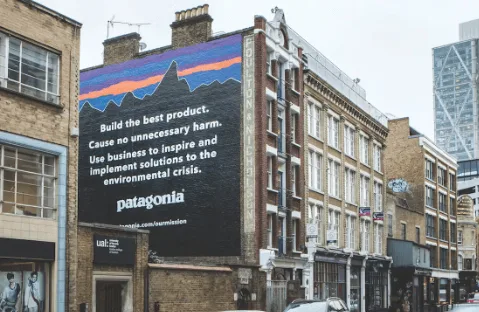
But then, when you land on their product pages and you’re in “hmm, is this right for me?” mode (AKA, mid construal thinking) they switch to making you imagine using the product. It’s all use-case details and concrete, tactile descriptions that narratively transport you away. Double smart.
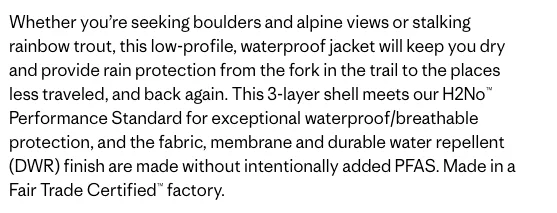
Then, as we get closer to checking out, we see this 👇
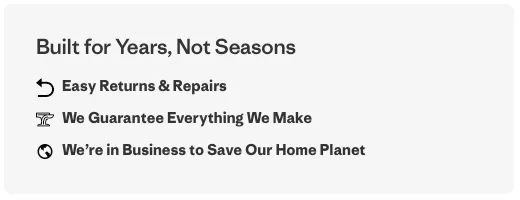
For starters, that “Built for Years, Not Seasons” bit of copy cleverly reframes the purchase as something that’s going to last (which means it feels like less of a risk and overcomes that objection).
Then the bullets kill any lingering logistical doubts about returns, repairs and guarantees.
Finally, the mission line loops identity back in so the last thing you see reminds you of why you loved this brand in the first place. Triple smart.
(Quick thing we noticed: it’s interesting that Patagonia don’t talk about delivery at all on their product pages when we know that impacts conversion rate. But when you look for the delivery options, you see this “We kindly ask that you choose standard shipping where possible to reduce our environmental impact.”. Which brings it all back to their “in the business of saving the planet” message again. Quadruple smart.)
Really, this is our approach to getting out of our heads faster so we can smash out some v.1 copy that we know is on the right track.
(Also, on a personal note, it stops us from writing a line we absolutely love that we then have to kill because it doesn’t quite work. That really sucks.)
Once you’ve got your v.1s locked in, you can do another sweep that brings in all the nerdy stuff that takes copy from a 7 to a 10 (like voice of customer research, adding your brand voice, etc…) before you ship it and test it.
But, of course, if you ever need a hand writing copy or just want two expert eyes to give you feedback on what you’ve already written and how you can make it better, you know where we are.
Dive into more free tips and tricks 👇
How Starface use orthography to build a killer brand voice their customers love
The words you write matter. But so do your full stops, emojis and lowercase letters. Learn how to turn punctuation into a powerful part of your brand voice.
Why Oatly’s brand voice is so damn good (and how yours can be, too)
We dig into the three layers of brand voice (10,000ft, 1,000ft, ground level), show how Oatly nails each one and how you can do it for your own brand.
The weekly newsletter that takes your brand’s copy from “meh” to “hell f*cking yeah!”
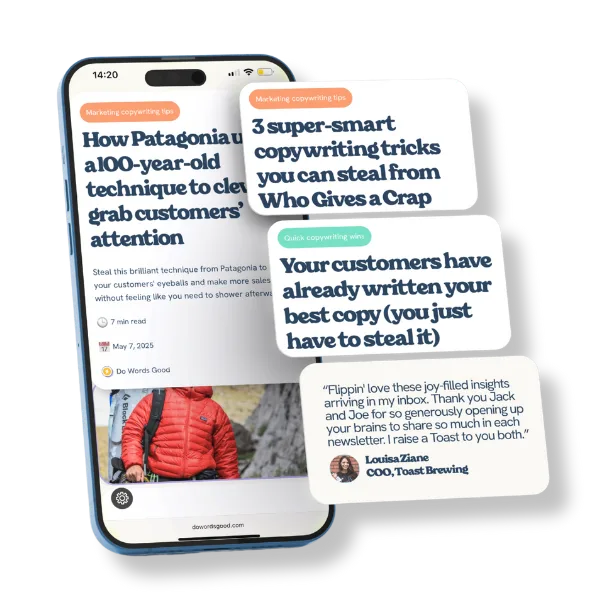
Read every week by legends at brands like these











